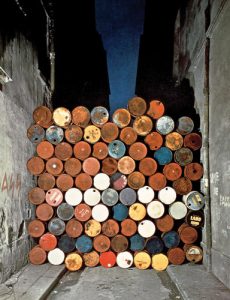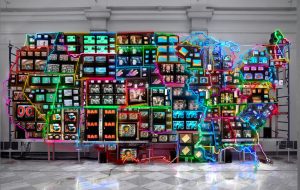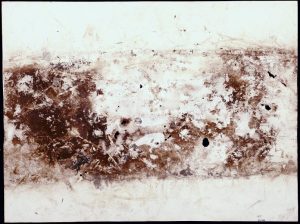Postmoderninsm came after modernism and became a rebellion against it.
The first thing I looked at was this photograph of Christo and Jeanne-Claude’s oil barrels, which they called the ‘Iron Curtain’. They stacked four metres high of metal oil barrels in a narrow street in Paris, blocking the road and creating a traffic jam as a protest against the build of the Berlin wall from 1961.
The barrels in the photograph aren’t organised, and the artists didn’t change the colours or peel off/paint over any brand names; they stacked the barrels up purely so no one could get through, and caused the street to become a dead end.
In 1995, Nam June Paik created a piece of installation art called the ‘Electronic Superhighway’ showing the whole of the USA on many television screens with 51 channels (one for each state) and surrounded in neon lighting. Paik argued that media would become more commonly used in
America and should awareness about social issues such as racism and pollution, and so he made this “superhighway” of television screens, audio cassettes and fibre optics.
I like this piece because it’s extremely thought out and detailed – down to the positioning of the screens, and I like that the neon lights show all the states of America.
In 1978, Jacek Tylicki put a sheet of watercolour paper down inbetween fallen trees of a forest in Sweden between September and October and waited for 28 days to see what would occur naturally on the paper.
This natural art is very unique because nature is very unpredictable and cannot be replicated . the colour of this whole piece is brown, and it’s also very textured. This may be from combining mud with leaves and sticks along with the wind blowing them onto the paper. I like this because I know that only nature has caused this, and the fact that none of it is manmade is amazing. I think the message behind this is that nature can be art as well as manmade art.
I think postmodernism overall is very different and unique, and is more focused on meaning in comparison to modernism.
Image One: The Iron Curtain, Christo & Jeanne-Claude, 1962 [online] available at: (http://christojeanneclaude.net/projects/wall-of-oil-barrels—the-iron-curtain) [accessed 6 December 2017]
Image Two: Electronic Superhighway, Nam June Paik, 1995 [online] available at: (https://www.khanacademy.org/humanities/ap-art-history/global-contemporary/a/paik-electronic-superhighway) [accessed 6 December 2017]
Image Three: Number 185, Jacek Tylicki, 1978 [online] available at: (http://www.tylicki.com/natural-art/#Tylicki_Natural_Art_185.jpg) [accessed 6 December 2017]



